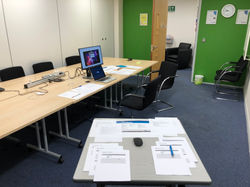by OSCAR MAYR
DEFRA
Created a user-centric GOV.UK service for licensing the import and export of Fgas and ODS, leading the project from the discovery phase to successful implementation.
Duration: 8 Months
VALUE DELIVERED
500 companies dealing with Fgas and ODS using this new service
66% reduction in time on task for users in relation to the EU service
Easy to use and manage licence application for import / export
88% adoption target met as dictated by the Government Digital Standards (GDS)
Users with accessibility requirements can now use the service
MY CONTRIBUTION
Led the design team including Service Designer, User Researcher, Content Strategist and Product Designer.
Driven the UX and service design approach on the project including DesignOps
Planned the design activities, conveyed the outcomes and state the risks and how to mitigate
Led the recruitment for resourcing the project
Assisted in rationalising opportunities for the roadmap and backlog by supporting service blueprinting, user interviews, and usability testing activities.
THE ASK
Provide a service that enables businesses to continue to comply with their legal obligations when importing, exporting and using fluorinated gases and ozone depleting substances.
Key Regulatory Goals:
-
To continue to fully comply with the Montreal Protocol
-
To meet annual reporting obligations
-
To control and monitor usage with Licence & Quota systems
Key business objectives:
-
To deliver the MOC for EU Exit Day 1
-
To provide a low cost supportable solution
-
To build the solution on the assumption that it will scale down over time, whilst also providing a basis for productivity improvements through simple automation during the service lifetime.
THE APPROACH
The project adopted a service design approach to prioritize the user experience and ensure that their needs were at the core of the new solution. This approach was aligned with the Government Digital Standards (GDS) which governs the development of GOV.UK websites and services.

DISCOVERY
During the discovery phase, our aim was to gather and comprehend information about the existing service and its users. Our goal was to identify and prioritise opportunities that aligned with the business requirements and create a backlog for the project.
The discovery phase was composed of the following steps:
1
Identify the audience.
2
Set up and run user interviews
(The selection screening criteria were mainly around demographics and years of work experience. 10% of the user base was selected for the remote interviews)
3
Define personas
(needs, goals, frustrations)
4
Map the AS-IS user journeys
(Identify opportunities)
5
Define backlog
 Identify audience |  F-GAS Persona |  ODS Persona |
|---|---|---|
 F gas User Journey Map Registration |  ODS User Journey Map Registration |  AS IS Mapping |
ALPHA (Define & Design)
During the Alpha phase, the objective was to establish the desired state of the service, create a prototype, test it with users, and iterate the design sprint model. It was critical to align the design team, Product Owner, and Solution Architect to ensure feasibility and business objectives were aligned with user needs.
1
Defined the TO BE blueprint
(Visualise the users [two personas] actions and interactions with the service represented by internal users and systems)
4
Prototype refined to Mid Fidelity
(The GOV.UK design system was utilised [code based]. The design team submitted two new design elements that became part of it)
2
Design the user flows
3
Rapid prototyping
5
Usability Testing
(Test goals were agreed with the PO beforehand. Test script and plan were drafted and signed-off. User recruited through a provided GOV.UK service)
 Rapid prototype |  Before - EU portal apply for Fgas quota |  After - GOV.UK Fgas apply for quota |
|---|---|---|
 TO BE blueprint in the making |  TO BE Service Blueprint |  User flows |
 Usability Testing Lab |  Usability testing results |
BETA (Private & Live)
During the Beta phase, which is considered the implementation phase, there are two stages, and the go-live for the public is only possible when the related minister gives the sign-off.
In this final phase, the engagement with the users becomes even more critical to ensure that the service is user-centric, useful, usable, and respects accessibility principles.
The following steps were undertaken to move the service from design and development to live:
1
Created a high-fidelity prototype
(Implemented any opportunities driven by usability testing from Alpha. Created a coded prototype wired with HotJar analytic tool)
4
Continuous update of the blueprint
(The TO-BE blueprint was updated keep track of the improvements and the areas where the service demonstrated flaws)
2
Unmoderated Remote Usability Testing
(The prototype was shared with about 25% of the live audience to gather additional insights on "what & how" it was used)
5
Iterations of the design prototype
(Proceeding with a design sprint fashion the prototype was kept live till go-live so constant delivery of value to the Dev team was made possible)
3
Ongoing User Research
(The user researcher was synthesising with a cadence of two weeks the data from HotJar to performed more narrow user interview to understand the "why" from the users)
6
Accessibility & Design QA
(The design was made accessible for two types of users, visual impaired and colour blind. Tags on the code were applied and a user testing organisation was involved. Every piece of the user journeys was quality assured by the design team to ensure consistency)
 System Usability Scale |  Goal completion rate |  Mouse movements |
|---|
CONCLUSIONS
Successfully delivering a user-centric service that provided dependable business operations to UK organizations was a great achievement.
It was a rewarding experience to lead a talented UX team in conducting user research, service design, product design, and content strategy to make the service usable, useful, and efficient within a tight timeline of 8 months.

